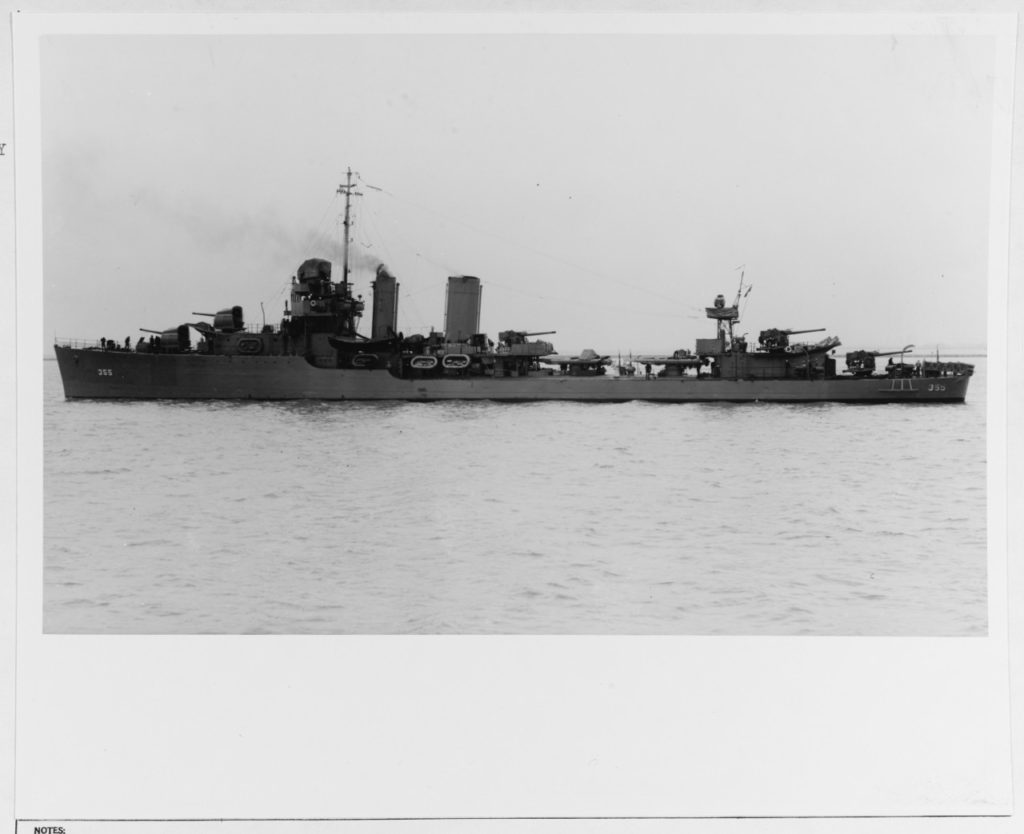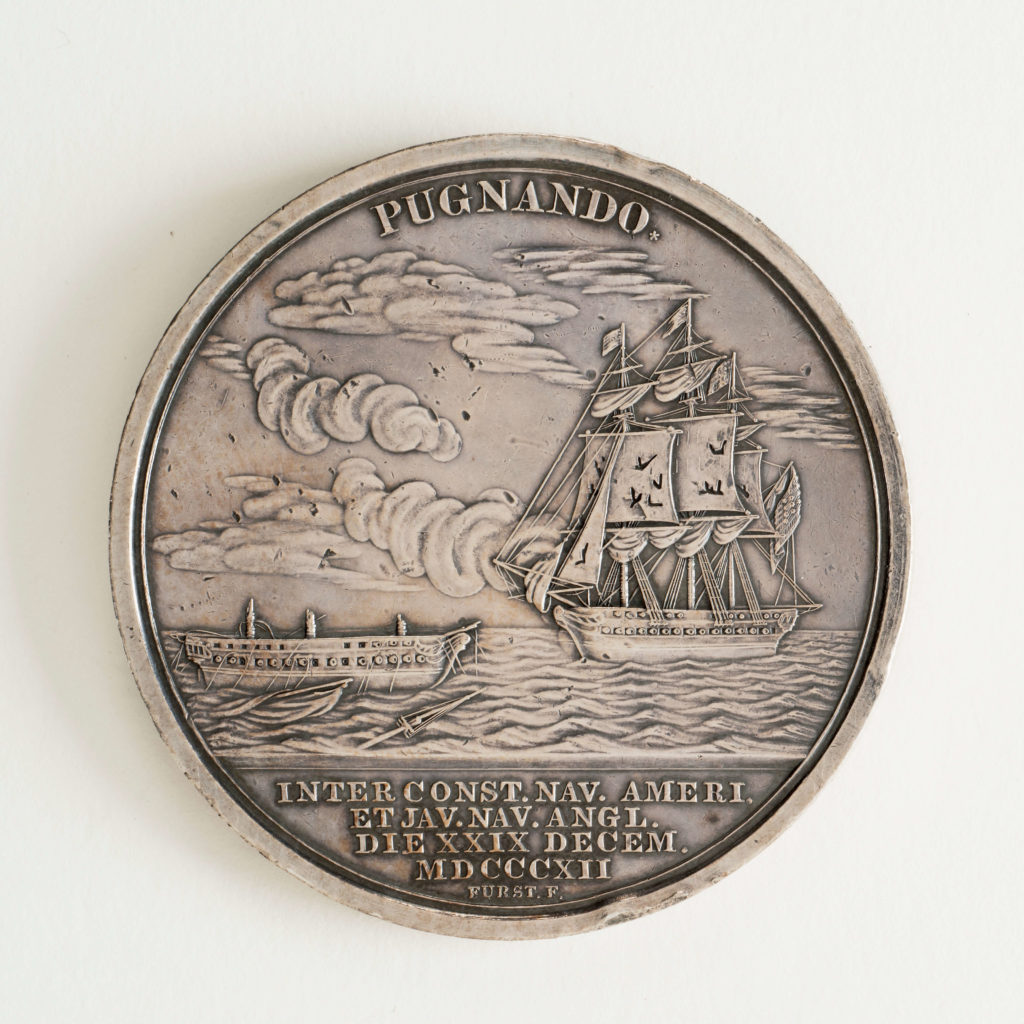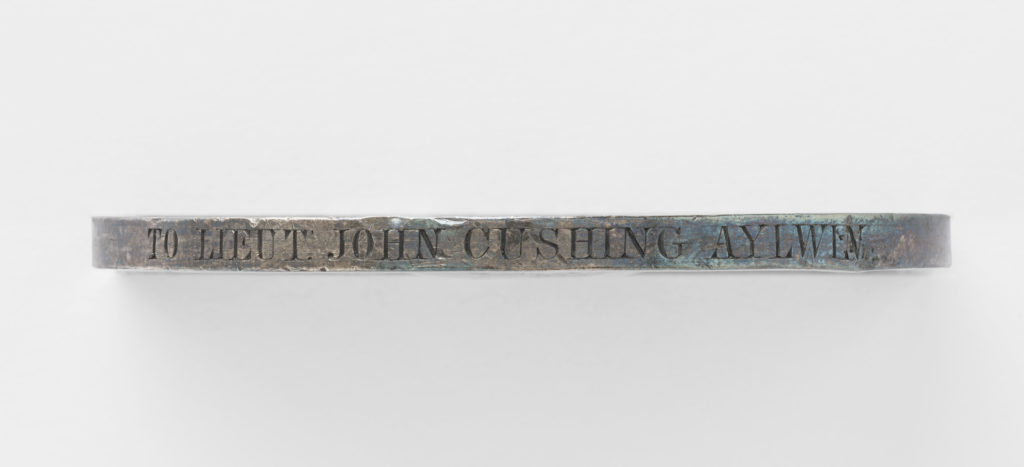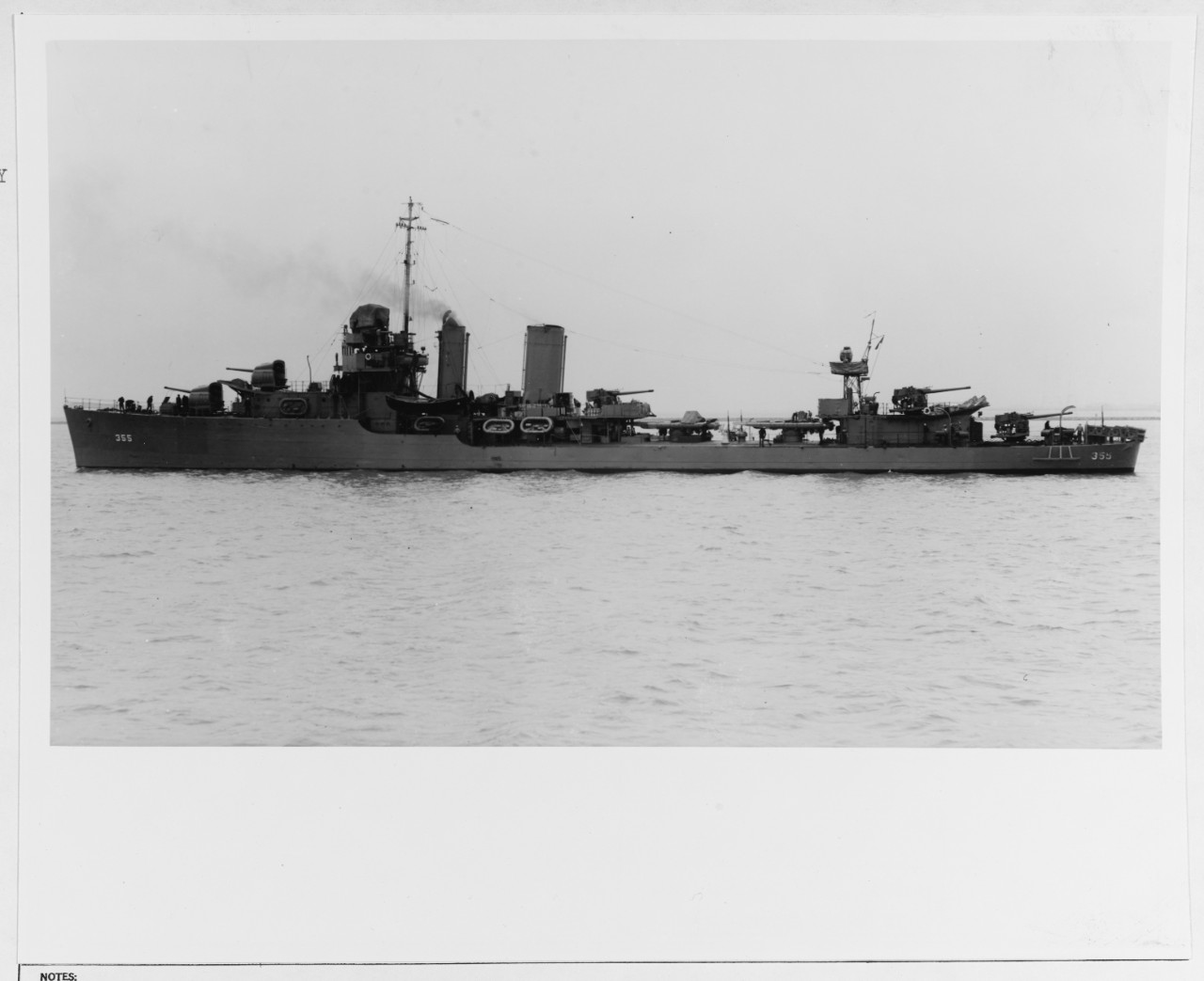In the early years of the War of 1812, USS Constitution deftly maneuvered around its enemies under the leadership of its sailing master, Lieutenant John Cushing Aylwin. From escaping from a British Squadron in the opening months of the war, to defeating HMS Guerriere and HMS Java in Constitution‘s first two battles, Aylwin led the sailhandling of the ship with skill. Unfortunately, Aylwin was struck by musket fire during the battle with HMS Java in December 1812 and later died from his wounds.
Though his naval career was cut short, Aylwin’s legacy of service lived on through one of his namesake vessels, the Farragut-class destroyer USS Aylwin (DD-355). Launched at the Philadelphia Navy Yard in 1934 and commissioned in 1935, USS Aylwin was the third of four U.S. Navy ships named for John Cushing Aylwin. USS Aylwin served in a variety of capacities in the Atlantic and Pacific Oceans in the years leading up to World War II, and arrived at Pearl Harbor in 1941.

As Aylwin approached the harbor entrance buoys, the ship’s commanding officer, Lieutenant Commander Robert H. Rogers, was seen with the other senior officers in a motor whaleboat chasing Aylwin from astern. Under full steam, and with orders from the destroyer squadron commander to not slow down,2 Aylwin proceeded out of the harbor while Rogers and the other officers boarded USS Chew (DD-106).3 As Brittin summarized in his oral history, “The opportunity is rare indeed for an ensign to refuse his captain’s request to come aboard, and further to sail off with his ship. We did just that.”4
Once outside the harbor, Aylwin was ordered to join with Vice Admiral William “Bull” Halsey’s carrier task force centered around USS Enterprise (CV-6) to search out and attack the Japanese carriers. As part the Enterprise task force, and still under Caplan’s command, USS Aylwin searched through the night for Japanese carriers. Caplan maintained command of the ship for approximately 36 hours until the Enterprise task force returned to Pearl Harbor on the afternoon of December 8. Upon their return, Lieutenant Commander Rogers met and reassumed command of Aylwin outside the harbor entrance and guided the ship back into Pearl Harbor.
In his after-action report to Commander, Destroyers, Battle Force on December 12, 1941, and again in his after-action report to the Commander-in-Chief, Pacific Fleet on January 4, 1942, Commander Rogers stated: “The conduct of Ensign S. CAPLAN, who has been at sea a total of eight months in superbly taking command for [33 to] 36 hours during war operations of the severest type is a most amazing and outstanding achievement.”5 In his report to the Commander-in-Chief, Pacific Fleet, Rogers “recommended that Ensign S. CAPLAN and Ensign H.C. Anderson, USNR., receive special commendation.”6
The bold, decisive actions in the heat of battle by Ensign Caplan and the crew of USS Aylwin was reminiscent of the skill and valor demonstrated by the ship’s namesake, Lieutenant John Cushing Aylwin, during the War of 1812. Before joining USS Constitution’s crew, Aylwin had several years of experience serving on many ships. This included at least five years as an impressed sailor on a British gun-brig in the Mediterranean, East Indies, Red Sea, and Indian Ocean.7 His ill health eventually allowed him to be released from the British Royal Navy in Boston, where he joined the crew of a merchant ship. As a result of his impressment, Aylwin understood deeply the reasons why the United States was fighting to protect the sailors’ rights in the War of 1812. He joined Constitution as sailing master in May 1812.
In July 1812, while at sea off Egg Harbor, New York, Aylwin used “every trick he learned in his nearly two decades at sea, crowding and wetting sail to take advantage of every feeble breeze as crew members simultaneously towed the frigate using small boats and a kedge” anchor during Constitution‘s escape from a squadron of five British warships.8 During the battle with HMS Guerriere on August 19, 1812, when Constitution earned the nickname “Old Ironsides,” Aylwin “expertly handled the frigate and put her alongside Guerriere while denying the enemy’s attempt to gain the weather gauge.”9 After Marine Lieutenant William Sharp Bush,10 commander of Constitution’s Marine Detachment, was killed in his attempted to lead his men over the taffrail onto the British frigate, Aylwin was wounded in the shoulder as he too mounted the rail. Aylwin survived and stayed at his post on the quarterdeck through the remainder of the battle.11 For his distinguished service in the victory over Guerriere, Aylwin was promoted to fifth lieutenant. Later that year, on December 29, Constitution engaged HMS Java in battle off the coast of Brazil. About a half-hour into the battle, as the ships “seemed destined to collide, Aylwin climbed atop the quarterdeck hammock lashings and fired a brace of pistols at enemy tars preparing to board. This fearless action exposed him to enemy fire and he was struck by musket fire or grapeshot…Despite the severity of the wound, the lieutenant remained at his post and did not call attention to his injury…Only after the surgeon had tended to all of the wounded on board did Aylwin reveal that he too, was hurt.”12
The injured Aylwin was ordered by Naval Surgeon Amos Evans to remain immobile in his cabin while his wound healed. But a few days later, when the crew was called to quarters after a ship’s sail was spotted the horizon, Aylwin ignored the surgeon’s advice. His wounds became gangrenous as a result of his exertions on deck. Aylwin succumbed to his injuries on January 28, 1813.13 Commodore William Bainbridge wrote that Aylwin “was an officer of great merit, much esteemed by all who had the pleasure of his acquaintance. He had seen much of the world, and improved his opportunities of observation; possessed a strong mind with a great benevolence of disposition. In his death our country has suffered a great loss.”14 Aylwin received a portion of the prize money for both Guerriere and Java, as well as Congressional silver medals for both victories. Nearly 130 years later, during the attack on Pearl Harbor on December 7, 1941, the junior crew of USS Aylwin served gallantly in the spirit of the ship’s namesake.


For another fascinating story about a WWII ship named after a sailor with connections to “Old Ironsides,” read our blog article about USS Ward (DD-139): “USS Constitution and the Day of Infamy.”
1 CAPT Burdick H. Brittin, USN (Ret.), “We Four Ensigns,” Paul Stillwell, ed. Air Raid: Pearl Harbor!: Recollections of a Day of Infamy (Annapolis, MD: Naval Institute Press, 1981) , p. 191.
2 While USS Aylwin‘s after action report indicates that the “Commander, Destroyer Squadron ONE refused to allow the Aylwin to slow,” Burdick Brittin reports in his oral history that, “Actually the reason we did not stop the ship to pick up the captain and commodore, who had followed us out of the harbor via small boat approximately one hour after our sortie, was not our orders to rendezvous with the Enterprise, but fear of submarines off Pearl.” Britton, p. 193. “USS Aylwin, Reports of Pearl Harbor Attack,” Naval History & Heritage Command. https://www.history.navy.mil/research/archives/digital-exhibits-highlights/action-reports/wwii-pearl-harbor-attack/ships-a-c/uss-aylwin-dd-355-action-reports.html
3 USS Chew’s namesake was Samuel Chew, an officer in the Continental Navy. One of Samuel Chew’s sons was Purser Thomas Chew who served on USS Constitution during the battle with HMS Guerriere on August 19, 1812.
4 Brittin, p. 193.
5 “USS Aylwin, Reports of Pearl Harbor Attack.” The two versions of the after-action report differ in the length of time Caplan was in command. The report to Commander, Destroyers, Battle Force cites 36 hours with the report to Commander-in-Chief, Pacific Fleet indicating he was in command for 33 hours.
6 Ibid.
7 “Aylwin III (DD-355),” Dictionary of American Naval Fighting Ships, Naval History & Heritage Command, https://www.history.navy.mil/research/histories/ship-histories/danfs/a/aylwin-iii.html; “John Cushing Aylwin,” Ship’s Crew, USS Constitution Museum. https://ussconstitutionmuseum.org/crew/john-cushing-aylwin/.
8 “Aylwin III (DD-355).”
9 Ibid.
10 Lieutenant William Sharp Bush would also have two destroyers named in his honor, including a Fletcher-class destroyer during World War II that was commissioned in 1943 and sank following a kamikaze attack at Okinawa. “Bush II (DD- 529),” Dictionary of American Naval Fighting Ships, Naval History & Heritage Command, https://www.history.navy.mil/research/histories/ship-histories/danfs/b/bush-ii.html.
11 “Aylwin III (DD-355).”
12 Ibid.
13 Ibid.
14 Ibid.
The Author(s)
Brian Miskell
Administrative Coordinator, USS Constitution Museum
Brian Miskell is the Administrative Coordinator at the USS Constitution Museum.
